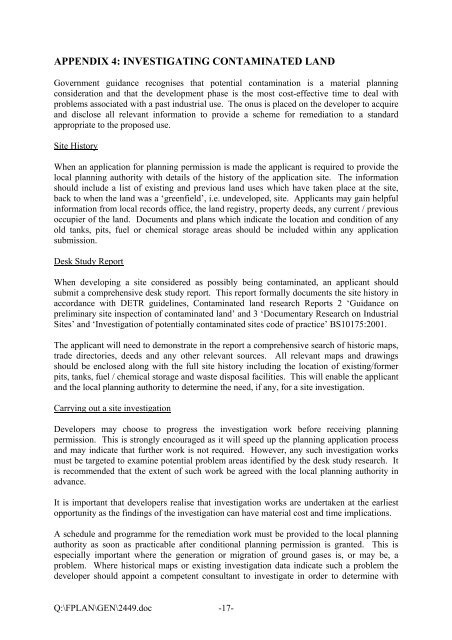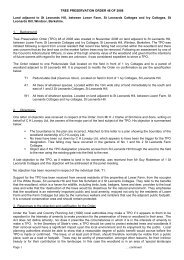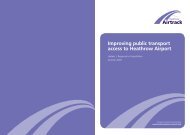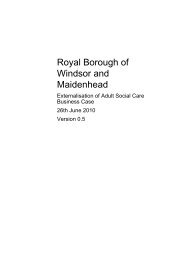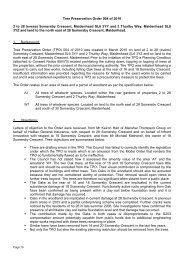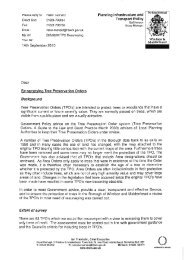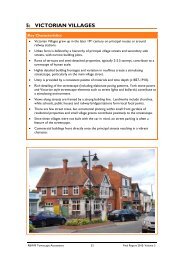Cookham Gas Holder Station - The Royal Borough of Windsor and ...
Cookham Gas Holder Station - The Royal Borough of Windsor and ...
Cookham Gas Holder Station - The Royal Borough of Windsor and ...
Create successful ePaper yourself
Turn your PDF publications into a flip-book with our unique Google optimized e-Paper software.
APPENDIX 4: INVESTIGATING CONTAMINATED LAND<br />
Government guidance recognises that potential contamination is a material planning<br />
consideration <strong>and</strong> that the development phase is the most cost-effective time to deal with<br />
problems associated with a past industrial use. <strong>The</strong> onus is placed on the developer to acquire<br />
<strong>and</strong> disclose all relevant information to provide a scheme for remediation to a st<strong>and</strong>ard<br />
appropriate to the proposed use.<br />
Site History<br />
When an application for planning permission is made the applicant is required to provide the<br />
local planning authority with details <strong>of</strong> the history <strong>of</strong> the application site. <strong>The</strong> information<br />
should include a list <strong>of</strong> existing <strong>and</strong> previous l<strong>and</strong> uses which have taken place at the site,<br />
back to when the l<strong>and</strong> was a ‘greenfield’, i.e. undeveloped, site. Applicants may gain helpful<br />
information from local records <strong>of</strong>fice, the l<strong>and</strong> registry, property deeds, any current / previous<br />
occupier <strong>of</strong> the l<strong>and</strong>. Documents <strong>and</strong> plans which indicate the location <strong>and</strong> condition <strong>of</strong> any<br />
old tanks, pits, fuel or chemical storage areas should be included within any application<br />
submission.<br />
Desk Study Report<br />
When developing a site considered as possibly being contaminated, an applicant should<br />
submit a comprehensive desk study report. This report formally documents the site history in<br />
accordance with DETR guidelines, Contaminated l<strong>and</strong> research Reports 2 ‘Guidance on<br />
preliminary site inspection <strong>of</strong> contaminated l<strong>and</strong>’ <strong>and</strong> 3 ‘Documentary Research on Industrial<br />
Sites’ <strong>and</strong> ‘Investigation <strong>of</strong> potentially contaminated sites code <strong>of</strong> practice’ BS10175:2001.<br />
<strong>The</strong> applicant will need to demonstrate in the report a comprehensive search <strong>of</strong> historic maps,<br />
trade directories, deeds <strong>and</strong> any other relevant sources. All relevant maps <strong>and</strong> drawings<br />
should be enclosed along with the full site history including the location <strong>of</strong> existing/former<br />
pits, tanks, fuel / chemical storage <strong>and</strong> waste disposal facilities. This will enable the applicant<br />
<strong>and</strong> the local planning authority to determine the need, if any, for a site investigation.<br />
Carrying out a site investigation<br />
Developers may choose to progress the investigation work before receiving planning<br />
permission. This is strongly encouraged as it will speed up the planning application process<br />
<strong>and</strong> may indicate that further work is not required. However, any such investigation works<br />
must be targeted to examine potential problem areas identified by the desk study research. It<br />
is recommended that the extent <strong>of</strong> such work be agreed with the local planning authority in<br />
advance.<br />
It is important that developers realise that investigation works are undertaken at the earliest<br />
opportunity as the findings <strong>of</strong> the investigation can have material cost <strong>and</strong> time implications.<br />
A schedule <strong>and</strong> programme for the remediation work must be provided to the local planning<br />
authority as soon as practicable after conditional planning permission is granted. This is<br />
especially important where the generation or migration <strong>of</strong> ground gases is, or may be, a<br />
problem. Where historical maps or existing investigation data indicate such a problem the<br />
developer should appoint a competent consultant to investigate in order to determine with<br />
Q:\FPLAN\GEN\2449.doc -17-


